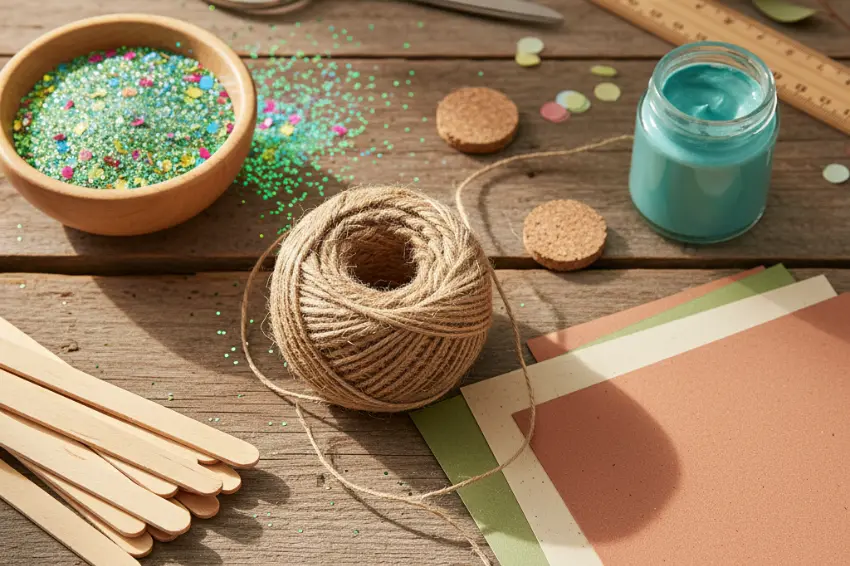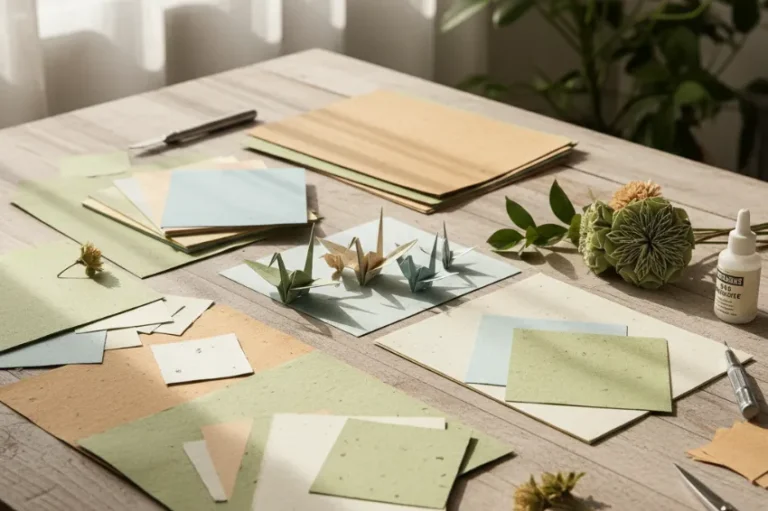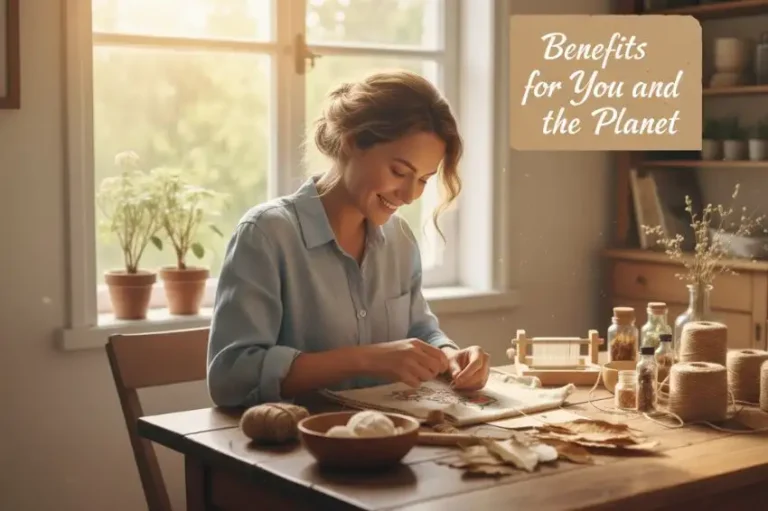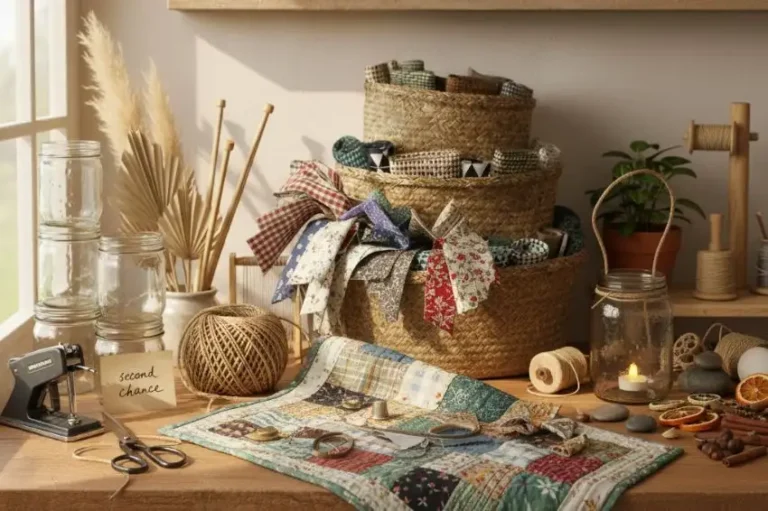Let’s be honest, there’s a magical, almost therapeutic feeling that comes from making something with your own two hands. That burst of creativity, the joy of a finished project… it’s fantastic. But then comes the cleanup.
If you’re anything like me, you’ve probably stared at the aftermath of a serious craft session—the tiny plastic trimmings, the non-recyclable glitter that’s everywhere, the foam scraps—and felt a little twinge of environmental guilt. It’s the uncomfortable paradox of creating beauty while also creating… well, trash.
For a long time, it felt like we had to choose: our creative hobbies or our love for the planet. But what if that’s a false choice?
Welcome to the wonderful world of biodegradable craft supplies. This isn’t about giving up your passion. It’s about upgrading it. It’s about making crafts smarter, cleaner, and kinder to the earth, without sacrificing an ounce of fun. Ready to dive in?
What’s the Big Deal About “Biodegradable” Anyway?
Okay, so “biodegradable” is a term that gets tossed around a lot, almost like “natural” or “healthy.” It sounds great, but what does it actually mean for our craft bin?
At its simplest, biodegradable means a material can be broken down by living organisms (like bacteria and fungi) and returned to the earth. It’s nature’s way of recycling.
This is a huge deal because so many of our go-to supplies are the exact opposite. Think about:
- Traditional Glitter: Those tiny, sparkly specks are, in reality, tiny, sparkly pieces of microplastic. They wash down our drains, get into our waterways, and end up in the food chain.
- Acrylic Paints: When we wash our brushes, the liquid plastics and chemical pigments go right down the drain, too.
- Polyester Felt & Foam Sheets: These are plastic-based. They’ll sit in a landfill for hundreds (if not thousands) of years, long after that cute holiday ornament has been forgotten.
Choosing eco-friendly craft materials isn’t about being perfect; it’s about making small, impactful swaps that reduce this long-term harm. It’s crafting with a conscience, and honestly, it feels pretty good.
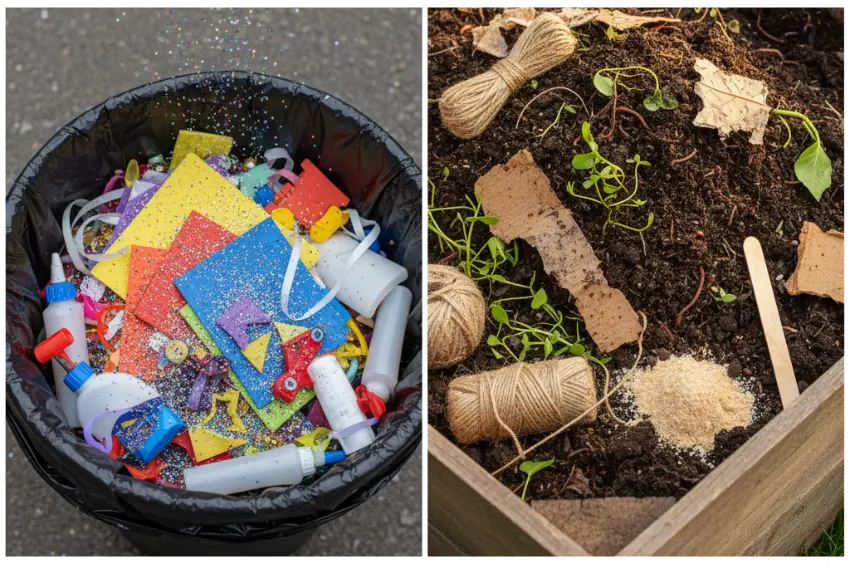
The “Crafting Culprits” and Their Amazing Eco-Swaps
The best way to start is to identify the worst offenders in your supply box and find their earth-friendly twins. You’ll be surprised at how easy (and beautiful) the alternatives are.
1. The Glitter Problem
We have to talk about glitter. It’s the confetti of the craft world, but it’s a microplastic nightmare. Once you know, you can’t un-know.
- The Swap: Plant-Based Biodegradable GlitterThis stuff is a game-changer. Often made from cornstarch (PLA) or eucalyptus cellulose, biodegradable glitter breaks down naturally. It’s just as sparkly, comes in all the same colors, and you can use it for your biodegradable glitter crafts without worrying that you’re accidentally feeding it to fish.
- How to Use It: Exactly the same way you’d use regular glitter! It works perfectly with non-toxic glues for kids’ projects, resin art (use bio-resin!), and homemade cards.
2. Paints and Glues
The “invisible” waste. Traditional paints and glues are full of synthetic polymers (aka plastics) and volatile organic compounds (VOCs) that are bad for the air and water.
- The Swap: Biodegradable Paints & Natural AdhesivesLook for eco-friendly and biodegradable paint options that are water-based and use natural, plant-based pigments. You can even find kits to make your own dyes from things like spinach, turmeric, and beets! For glue, there are fantastic non-toxic, biodegradable adhesives (like glue sticks) available. Or, go old-school: a simple flour-and-water paste is surprisingly strong, 100% compostable, and perfect for paper-mâché.
3. The Craft Base
We’ve all used a styrofoam ball or a plastic plate as a base for a wreath, a mask, or a kids’ project. They’re cheap, light, and… immortal.
- The Swap: Compostable Natural Craft MaterialsThis is where nature really shines. Instead of plastic, try:
- Sugarcane Bagasse Plates: These are the sturdy, molded-fiber plates you see at eco-friendly parties. They’re the perfect base for masks, ornaments, or collages.
- Palm Leaf Plates: Even more rustic and beautiful, these are stiff, textured, and look amazing as a base for a centerpiece.
- Recycled Cardstock: For anything needing a flat, stiff backing, this is your go-to.
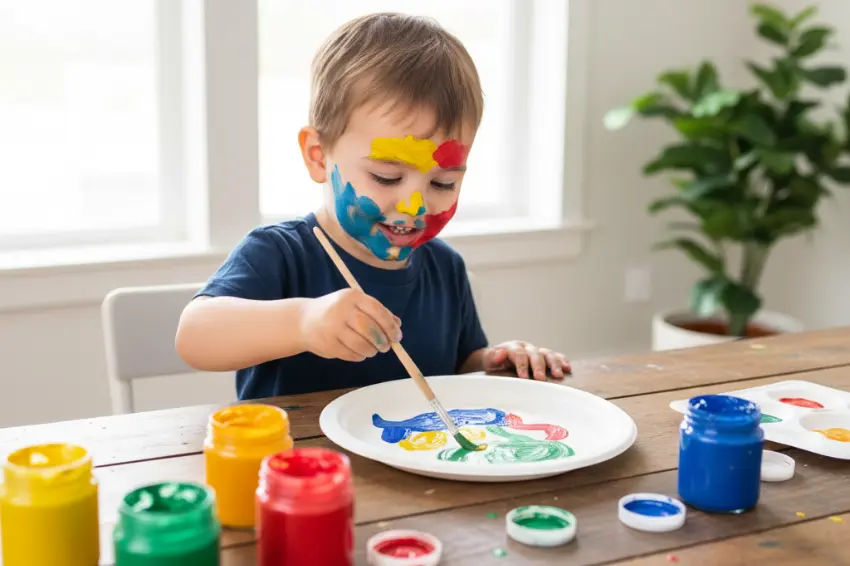
4. Fabrics and Fibers
That colorful polyester felt and shiny acrylic yarn? Plastic, plastic, plastic.
- The Swap: Natural FibersThis swap feels like a luxury upgrade.
- Organic Cotton Fabric: Incredibly soft, pesticide-free, and it biodegrades beautifully.
- Wool Felt Sheets: Unlike its eco-unfriendly cousin, real wool felt is 100% natural, renewable (thanks, sheep!), and compostable.
- Jute & Hemp: For
natural fiber supplies for biodegradable crafts, you can’t beat twine and fabric made from jute or hemp. They’re strong, have a wonderful rustic texture, and are ideal for everything from gift wrapping to macramé.
Are Eco-Friendly Supplies Practical? (The Kid & Budget Test)
This is the question I get asked most. It’s great that it’s good for the earth, but is it good for my wallet and my schedule?
Let’s break down the two biggest concerns: safety and cost.
Are Biodegradable Craft Supplies Safe for Kids?
Absolutely. In fact, they are often safer.
Think about it: sustainable craft supplies are made from things like plants, minerals, and natural fibers. They are less likely to contain the harsh chemicals, solvents, and plastics found in conventional supplies.
This makes them some of the best biodegradable craft supplies for kids and an obvious choice for biodegradable craft supplies for schools. You get less “what’s in this?” anxiety and more peace of mind.
Are They More Expensive?
This is the big one. The honest answer? Sometimes, but not always.
- The “Splurge”: Yes, a container of high-quality, plant-based glitter might cost more upfront than a cheap plastic tube.
- The “Save”: Many
natural biodegradable craftsare actually free. A project using twigs, pressed flowers, pinecones, and acorns gathered from the backyard costs $0. - The “Trade-Off”: A DIY flour-and-water glue is pennies per batch.
Recycled paper cardstockis often comparable in price to new.
My advice? Start small. You don’t need to replace your entire craft room overnight. The next time you run out of glitter, buy the biodegradable kind. When you’re out of paper plates for that school project, grab the sugarcane ones. It’s about progress, not perfection.
Where to Buy Biodegradable Craft Supplies Online
Okay, you’re convinced. But where do you find this stuff? While big-box craft stores are slowly catching on, your best bet is often online. Specialty eco-stores, Etsy, and dedicated suppliers are treasure troves.
We’ve rounded up some of our favorite Top Product Recommendations to get you started.
| Product Category | Product Name | Why We Love It |
| Glitter | Cornstarch-Based Biodegradable Glitter | It sparkles just like the real (plastic) thing but is 100% compostable and non-toxic. |
| Paints | Biodegradable Paint Set | Plant-based and non-toxic, these paints are vibrant and safe for even the smallest hands. |
| Adhesives | Biodegradable Glue Sticks | A simple, non-toxic swap for a school and craft essential. Finally, a guilt-free glue stick! |
| Craft Bases | Sugarcane Bagasse Plates | Super versatile. They’re sturdy, paintable, and perfect for masks, ornaments, or party crafts. |
| Paper | Biodegradable Seed Paper | This is crafting that gives back. Make a card, and the recipient can plant it to grow wildflowers. |
| Fibers | Natural Jute Twine | The ultimate rustic-chic supply. Use it for wrapping, hanging, or weaving. |
| Fabrics | Organic Cotton Fabric | A must-have for any eco-sewing projects. Soft, durable, and pesticide-free. |
| Kits | DIY Plant Dye Kit | For the truly adventurous crafter. Learn to make your own beautiful, all-natural dyes from plants. |
Get Started: 3 Fun DIY Biodegradable Craft Projects
The best way to learn is by doing! Here are a few simple, fun projects to get you started.
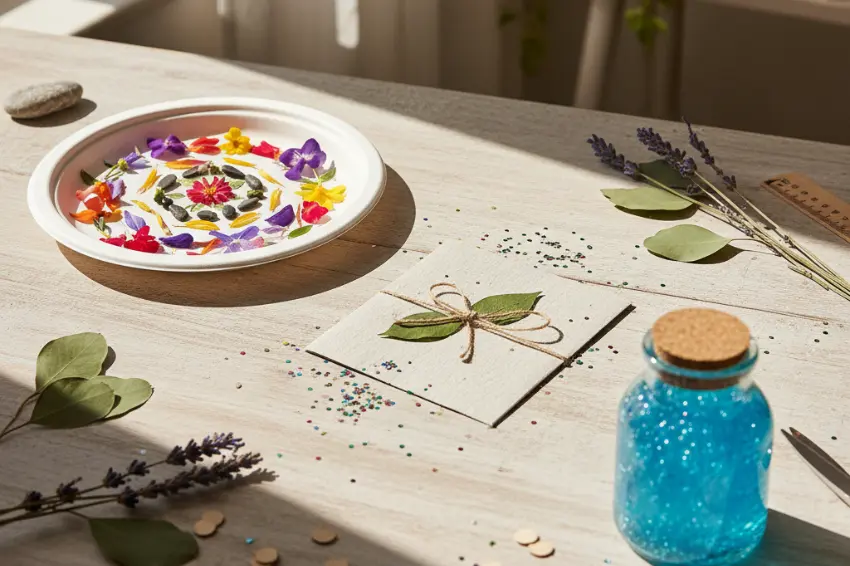
1. The “Plant-a-Card” Greeting
- Supplies:
Biodegradable Seed Paper, scissors, biodegradable paint or markers, natural jute twine. - How-To: Cut the seed paper into a card shape. Decorate it with a heartfelt message using your eco-friendly paints. (Keep the paint light so you don’t saturate the seeds). Instead of an envelope, you can roll it like a scroll and tie it with jute twine. The entire gift is the card and a future patch of flowers.
2. The Backyard Nature Mandala
- Supplies: A
Palm LeaforBagasse Plateas your base, biodegradable glue (or flour paste), and your “natural treasures.” - How-To: This is one of the best
DIY biodegradable craft projectsfor kids. Go on a nature walk and collect fallen leaves, small twigs, pebbles, flower petals, and acorns. Back at home, arrange your treasures in a beautiful circular pattern (a mandala) on the plate, using your eco-glue to hold them in place. It’s a gorgeous, temporary piece of art that can be composted when you’re done.
3. Sparkly (and Safe) Eco-Slime
- Supplies: 1/2 cup non-toxic white glue, 1/2 tsp baking soda, 1 tbsp saline solution (contact lens solution), and 1-2 tbsp of
biodegradable glitter. - How-To: Mix the glue, baking soda, and glitter in a bowl. Add the saline solution and stir, stir, stir! It will start to pull away from the bowl and form a slime. Knead it for a minute or two. You get all the sensory fun of glitter slime, without a single speck of microplastic.
Your Craft Table Can Be Creative and Conscious
Switching to biodegradable craft supplies isn’t just a trend; it’s a thoughtful return to the way crafting used to be—using natural, simple, and sustainable materials.
It’s a way to connect with our creativity and the earth at the same time. You don’t have to do it all at once. Just start with one swap. Buy one eco-glitter. Try one flour-paste project.
Every little bit helps us move toward a future where we can create beautiful things without leaving a harmful trace behind.
So, what’s your first eco-craft going to be? Do you have a favorite sustainable swap you’ve already made? Drop a comment below and share your ideas! Let’s inspire each other.
Frequently Asked Questions (FAQs)
So, how long does it actually take for biodegradable supplies to decompose?
This is a great question, and the answer is: it depends! Unlike plastic, which takes centuries, biodegradable art supplies break down in a timeline that nature can handle. A paper-based item might decompose in a few weeks or months in a compost bin. A plant-based bioplastic (like PLA glitter) might take 6-12 months under the right conditions. This is still infinitely faster than the 500+ years for its plastic equivalent.
I see “Home Compostable” and “Industrially Compostable” on labels. What’s the difference?
This is a super important distinction.
Home Compostable: This means you can toss the item right into your backyard compost bin. It’s designed to break down at lower temperatures with the bugs and fungi you have at home. Think: biodegradable seed paper, natural fibers (jute, wool, cotton), and un-laminated paper plates.
Industrially Compostable (or just “Compostable”): This usually means the material (often a bioplastic like PLA) needs the high heat and specific conditions of a commercial composting facility to break down. It likely won’t break down in your backyard bin. Check with your local city’s composting program to see if they accept these.
Can I make my own biodegradable craft supplies at home?
Yes! This is one of the most fun and budget-friendly parts of eco crafts biodegradable living. You can easily make:
Natural Glue: A simple paste of flour, water, and a pinch of salt.
Natural Dyes: Boil kitchen scraps like onion skins (yellow/orange), avocado pits (pink), or red cabbage (blue/purple) to create beautiful dyes for fabric or paper.
DIY “Paint”: Mix flour, salt, water, and natural food coloring for a simple, non-toxic finger paint.
Nature’s “Glitter”: Finely chop dried, colorful leaves or flower petals for a beautiful, all-natural confetti.

